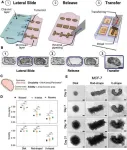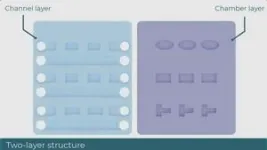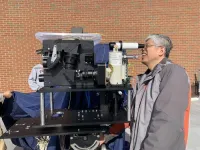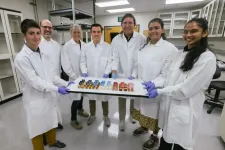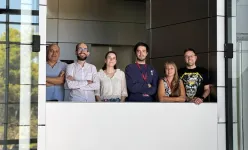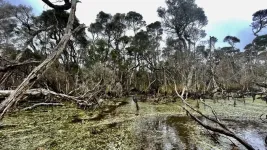(Press-News.org) Researchers at the University of Toronto’s Faculty of Applied Science & Engineering have designed a new microfluidic platform that allows forunprecedented control and manipulation of tumor shapes — a largely unexplored area with great potential to advance cancer research.
The work, led by Professor Edmond Young, offers new insights into how the shape of tumours can predict cancer cell behaviour and aggressiveness, which opens new pathways for more personalized and targeted cancer care.
“While there are several platforms for in vitro modelling of spheroids — three-dimensional aggregates of cells that can mimic tissues and mini tumours — a challenge in the cancer research field has been the inability to control the shape, recovery and location of these cancer organoids,” says Sina Kheiri, the co-lead author of the study, which was recently published in Advanced Materials.
“So, researchers end up with these tumours-on-a-chip that can’t be easily characterized because they are stuck on the device and can only be observed through optical microscopy.”
The new platform, called Recoverable-Spheroid-on-a-Chip with Unrestricted External Shape (ReSCUE), gives researchers the ability to recover and release tumoroids to perform downstream analysis and characterization.
The platform also enables researchers to grow cancer organoids in any shape they want. This is important, Kheiri says, because much of the current research on cancer cell in vitro modelling is focused on spherical shaped tumors, but tumors in a body can take many different shapes.
“In many invasive cancers, the tumor shape is not spherical,” he says. “For example, in a recent study of 85 patients with breast cancer, only 20% of tumors were spherical.
“If modelling studies are limited to spherical tumour shapes, then we are not looking at the full parametric space and scale of tumors that are seen in real life. We are only looking at a small portion of the whole answer to understand cancer cell behaviour.”
Kheiri’s PhD research was co-supervised by Young and Professor Eugenia Kumacheva, who is from the University of Toronto's Department of Chemistry and cross-appointed to the Institute of Biomedical Engineering.
The development of the ReSCUE platform was conducted in collaboration with Dr. David Cescon, a clinical scientist and breast medical oncologist at Princess Margaret Cancer Centre in Toronto. Cescon’s team provided access to the cancer cells that were used to form breast cancer organoids.
The multi-layer platform also uses EKGel, a biomimetic hydrogel developed by Kumacheva’s lab group, which acts as a scaffold, allowing the patient-derived cancer cells to grow and organize the way they would in vivo, inside human tissue.
The idea that tumour shapes determine cancer cell behaviour was a serendipitous discovery for Kheiri. When he was optimizing and developing the microfluidic platform, he discovered that some of the patient-derived tumoroids were forming positive curvatures because of the shape of the microwell.
“I was playing with the aspect ratio of the microwells and observed that when the wells had a more rod-like or elongated shape, rather than a circular or disc shape, the tissues formed cellular strands at the regions with positive curvature,” he says.
“I didn’t see that in tumoroids from the same cancer-cell sample that formed a spherical shape. So, we started to make different shapes and analyze the effects of shape or curvature on cancer behaviour.”
The team looked at disk-, rod- and U-shaped tumoroids and they found higher cell activity and higher proliferation at the positive curvatures — where the tumour shape is convex, outward curving.
This could mean that the growth of cells in these areas is more invasive compared to areas of the tumour that have a flat curvature.
“Understanding the relationship between tumor shape and cell behavior is important for predicting tumor aggressiveness and planning appropriate treatment strategies, such as targeted radiation therapy or drug delivery,” says Kheiri.
“We want to open this door and give researchers a platform that they can use to study how different tumour shapes respond in anti-cancer drug treatment, in radiotherapy and chemotherapy.”
Kheiri is currently a postdoctoral researcher at the Massachusetts Institute of Technology (MIT), but he is continuing to provide support to the Young Lab on the continued development of the ReSCUE platform. The researchers have recently submitted a U.S. patent and are looking to build on their results.
“We hope that these uniquely shaped mini tumors can help biologists and cancer researchers better understand the biology of cancer cells and how they respond to drugs,” says Young.
“We’re going to add even more complex features, such as surrounding vasculature. The more control we have over the features we can include in our models, the more realistic they become, and the more accurate our drug testing will be.”
END
New microfluidic device reveals how the shape of a tumour can predict a cancer’s aggressiveness
ReSCUE platform, developed by University of Toronto researchers, also enables the formation, release and transfer of patient-derived tumoroids
2024-11-15
ELSE PRESS RELEASES FROM THIS DATE:
Speech Accessibility Project partners with The Matthew Foundation, Massachusetts Down Syndrome Congress
2024-11-15
The Speech Accessibility Project has two new partners — The Matthew Foundation and the Massachusetts Down Syndrome Congress — as it continues to recruit adults with Down syndrome who live in the United States and Canada. The project also allows residents of Puerto Rico to participate.
The project is also recruiting those with ALS, cerebral palsy and Parkinson’s disease, as well as individuals who have had a stroke.
“The research team has learned that connecting with trusted partners is key to showing the credibility of our work and how much it could improve the lives of people with disabilities,” said Mark ...
Mass General Brigham researchers find too much sitting hurts the heart
2024-11-15
Fitting in a workout after a long day of sitting at a desk might not be enough to compensate for the impacts of sedentary behavior on the heart. Investigators from Mass General Brigham, found that excessive sedentary behavior (waking activity with low energy expenditure while sitting, reclining, or lying down and not including hours spent sleeping at night) was linked to increased risk of heart disease, especially heart failure and cardiovascular death, and that these risks could be significantly reduced by substituting sedentary time for other activities. They also found that meeting guideline levels of moderate-to-vigorous physical activity may be insufficient on its own to reduce cardiovascular ...
New study shows how salmonella tricks gut defenses to cause infection
2024-11-15
A new UC Davis Health study has uncovered how Salmonella bacteria, a major cause of food poisoning, can invade the gut even when protective bacteria are present. The research, published in the Proceedings of the National Academy of Sciences, explains how the pathogen tricks the gut environment to escape the body's natural defenses.
The digestive system is home to trillions of bacteria, many of which produce short-chain fatty acids (SCFAs) that help fight harmful pathogens. But Salmonella manages to grow and spread in the gut, even though ...
Study challenges assumptions about how tuberculosis bacteria grow
2024-11-15
The rod-shaped tuberculosis (TB) bacterium, which the World Health Organization has once again ranked as the top infectious disease killer globally, is the first single-celled organism ever observed to maintain a consistent growth rate throughout its life cycle. These findings, reported by Tufts University School of Medicine researchers on November 15 in the journal Nature Microbiology, overturn core beliefs of bacterial cell biology and hint at why the deadly pathogen so readily outmaneuvers our immune system and antibiotics.
"The ...
NASA Goddard Lidar team receives Center Innovation Award for Advancements
2024-11-15
NASA researchers Guan Yang, Jeff Chen, and their team received the 2024 Innovator of The Year Award at the agency’s Goddard Space Flight Center in Greenbelt, Maryland, for their exemplary work on a lidar system enhanced with artificial intelligence and other technologies.
Like a laser-based version of sonar, lidar and its use in space exploration is not new. But the lidar system Yang and Chen’s team have developed — formally the Concurrent Artificially-intelligent Spectrometry and Adaptive Lidar System (CASALS) — can produce higher resolution data within a smaller space, significantly increasing efficiency compared to current models.
The ...
Can AI improve plant-based meats?
2024-11-15
Cutting back on animal protein in our diets can save on resources and greenhouse gas emissions. But convincing meat-loving consumers to switch up their menu is a challenge. Looking at this problem from a mechanical engineering angle, Stanford engineers are pioneering a new approach to food texture testing that could pave the way for faux filets that fool even committed carnivores.
In a new paper in Science of Food, the team demonstrated that a combination of mechanical testing and machine learning can describe food texture with striking similarity to human taste testers. Such a method could speed up the development of new and better plant-based meats. The team also found that ...
How microbes create the most toxic form of mercury
2024-11-15
Mercury is extraordinarily toxic, but it becomes especially dangerous when transformed into methylmercury – a form so harmful that just a few billionths of a gram can cause severe and lasting neurological damage to a developing fetus. Unfortunately, methylmercury often makes its way into our bodies through seafood – but once it’s in our food and the environment, there’s no easy way to get rid of it.
Now, leveraging high-energy X-rays at the Stanford Synchrotron Radiation Lightsource (SSRL) at the U.S. Department of Energy’s SLAC National Accelerator Laboratory, ...
‘Walk this Way’: FSU researchers’ model explains how ants create trails to multiple food sources
2024-11-15
It’s a common sight — ants marching in an orderly line over and around obstacles from their nest to a food source, guided by scent trails left by scouts marking the find. But what happens when those scouts find a comestible motherlode?
A team of Florida State University researchers led by Assistant Professor of Mathematics Bhargav Karamched has discovered that in a foraging ant’s search for food, it will leave pheromone trails connecting its colony to multiple food sources when they’re available, ...
A new CNIC study describes a mechanism whereby cells respond to mechanical signals from their surroundings
2024-11-15
To the casual eye, a memory foam mattress would appear to have no relationship to the behavior of cells and tissues. But an innovative study carried out at the Centro de Investigaciones Cardiovasculares (CNIC) in Madrid shows that viscoelasticity—the capacity of a material to be compressed and then recover its original form, like memory foam—is a little-explored property of biological tissues that is essential for correct cell function.
Study leader Dr. Jorge Alegre-Cebollada, who heads the Molecular Mechanics of the Cardiovascular System laboratory at the CNIC, explained that proper cell function requires ...
Study uncovers earliest evidence of humans using fire to shape the landscape of Tasmania
2024-11-15
Some of the first human beings to arrive in Tasmania, over 41,000 years ago, used fire to shape and manage the landscape, about 2,000 years earlier than previously thought.
A team of researchers from the UK and Australia analysed charcoal and pollen contained in ancient mud to determine how Aboriginal Tasmanians shaped their surroundings. This is the earliest record of humans using fire to shape the Tasmanian environment.
Early human migrations from Africa to the southern part of the globe were well underway during the early part of the last ice age – humans reached northern ...
LAST 30 PRESS RELEASES:
New expert guidance urges caution before surgery for patients with treatment-resistant constipation
Solar hydrogen can now be produced efficiently without the scarce metal platinum
Sleeping in on weekends may help boost teens’ mental health
Study: Teens use cellphones for an hour a day at school
After more than two years of war, Palestinian children are hungry, denied education and “like the living dead”
The untold story of life with Prader-Willi syndrome - according to the siblings who live it
How the parasite that ‘gave up sex’ found more hosts – and why its victory won’t last
When is it time to jump? The boiling frog problem of AI use in physics education
Twitter data reveals partisan divide in understanding why pollen season's getting worse
AI is quick but risky for updating old software
Revolutionizing biosecurity: new multi-omics framework to transform invasive species management
From ancient herb to modern medicine: new review unveils the multi-targeted healing potential of Borago officinalis
Building a global scientific community: Biological Diversity Journal announces dual recruitment of Editorial Board and Youth Editorial Board members
Microbes that break down antibiotics help protect ecosystems under drug pollution
Smart biochar that remembers pollutants offers a new way to clean water and recycle biomass
Rice genes matter more than domestication in shaping plant microbiomes
Ticking time bomb: Some farmers report as many as 70 tick encounters over a 6-month period
Turning garden and crop waste into plastics
Scientists discover ‘platypus galaxies’ in the early universe
Seeing thyroid cancer in a new light: when AI meets label-free imaging in the operating room
Neutrophil-to-lymphocyte ratio may aid risk stratification in depressive disorder
2026 Seismological Society of America Annual Meeting
AI-powered ECG analysis offers promising path for early detection of chronic obstructive pulmonary disease, says Mount Sinai researchers
GIMM uncovers flaws in lab-grown heart cells and paves the way for improved treatments
Cracking the evolutionary code of sleep
Medications could help the aging brain cope with surgery, memory impairment
Back pain linked to worse sleep years later in men over 65, according to study
CDC urges ‘shared decision-making’ on some childhood vaccines; many unclear about what that means
New research finds that an ‘equal treatment’ approach to economic opportunity advertising can backfire
Researchers create shape-shifting, self-navigating microparticles
[Press-News.org] New microfluidic device reveals how the shape of a tumour can predict a cancer’s aggressivenessReSCUE platform, developed by University of Toronto researchers, also enables the formation, release and transfer of patient-derived tumoroids
